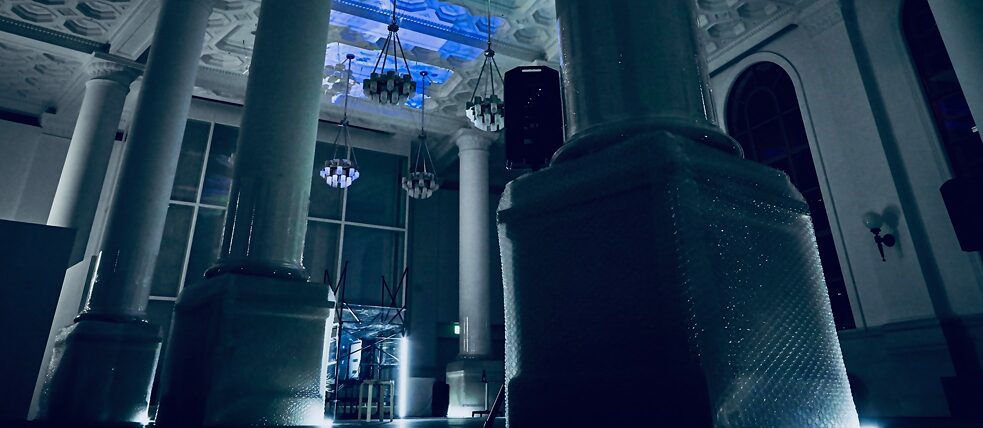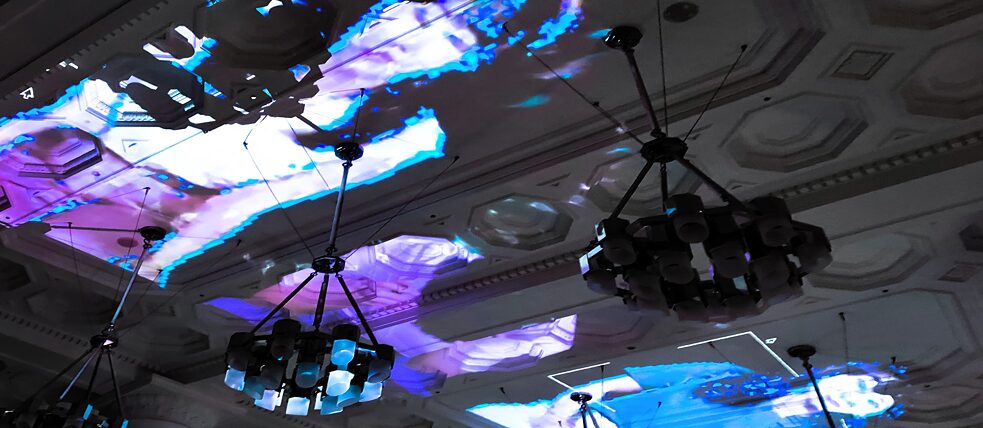Covered Culture in Yokohama
More Than the Hum of Its Parts

Composer Brigitta Muntendorf and dramaturge Moritz Lobeck created the audio-visual installation “Covered Culture,” commissioned by the Goethe-Institut. In an interview with “The Latest at Goethe”, they talk about the importance of Beethoven in the twenty-first century and a possible parallel to Neil Young.
By Carla Jamatte
What awaits visitors in the audio-visual installation “Covered Culture”?
Lobeck/Muntendorf: “Covered Culture” can be presented in a black box as well as in a white cube and also works as a site-specific installation. The visitors to the Duolon Museum of Modern Art with a view over the roofs of Shanghai were received very differently than in the dance studio in Berlin’s Radialsystem or the hypermodern LOOP Alt Space in Seoul. Its stops at the KAGAN Art Hotel for Kyoto Experiment or at TPAM – Performing Arts Meeting in Yokohama, where “Covered Culture” turned the impressive neoclassical lobby of a former bank building into an acoustic and visual projection space, are yet another experience.
The specific histories and varying designs of these spaces emphasise a central idea of the installation consisting of ten loudspeakers and video projections. Visitors in quite different places become part of a community, for a moment they can be members of a virtual, humming chorus. They are voices and choruses that could hardly be more different, and almost all were recorded in different locations, like the experimental pop singer SHII of China and the voice acrobat Maki Ota of Japan, the opera chorus of the German National Theatre Weimar and the Beijing Queer Chorus.
The montage of these single, softly humming and intimate voices and their images is an attempt to develop an anthem based on the idea of a hyperculture that is neither sung in unison nor belted loudly. It also critically questions our understanding of celebratory cultures. The entire installation is musically based on a quote from the “Ode to Joy.” Humming – a mainly private, personal act and also deliberately rather inartistic and limited in range – eludes attributions of nationality, gender, age and musical genre. At the same time – and this is what makes it so special – it refers to the chorus that grows out of the private and fragile and cannot get rid of this “origin.” Even when lots of people hum, there is no pathos.
 The lobby of BankART Temporary in Yokohama | Photo (detail): © Goethe-Institut Tokyo
The lobby of BankART Temporary in Yokohama | Photo (detail): © Goethe-Institut Tokyo
Lobeck/Muntendorf: We developed processes with each of the ensembles and singers, with rehearsals and recording in remotely controlled settings essentially shaping the project. While we were rehearsing and recording on stage with the opera chorus in Weimar, we worked with the singers and performers in Asia on screens and with chat software and developed all of the audio and video recordings with teams on site. In addition, we had already launched an open call at the end of 2019 and received audio and video recordings from amateurs and professionals who hummed to fragments of Beethoven’s ode based on a given audio score and electronic sounds.
These processes clearly needed more time for preparation, coordination, rehearsals and planning but we were completely amazed at how intensively a process can be influenced even on a small screen and at such great distances and how many unforeseen things can still foil our plans. For example, we unintentionally walked the night streets of Beijing with the Beijing Queer Chorus during a rehearsal, because a member of the chorus forgot to turn off the cell phone camera during rehearsals via video chat.
 „Covered Culture“ in Yokohama | Photo (detail): © Goethe-Institut Tokyo
„Covered Culture“ in Yokohama | Photo (detail): © Goethe-Institut Tokyo
Lobeck/Muntendorf: When 10,000 people sing the “Ode to Joy” at a mega-event organised by Japan’s largest whiskey manufacturer in Osaka, it seems that the anthem in this form has a perhaps less common appeal in Japan’s culture. In several interviews and documentaries about this event, conductors, singers and audience talk about how connecting and assertive this anthem is, how liberating from individual aberrations and how intoxicating in its collective pathos.
But this pathos is precisely the problem: The Nazis played the Ninth Symphony on Hitler’s birthday, it was the national anthem of the apartheid regime in Rhodesia (now Zimbabwe), and NATO selected it for the opening of its Brussels headquarters. If Beethoven were alive today, he probably would have objected just like Neil Young did when Trump used “Rockin’ in the Free World” for his election campaign ... Perhaps our idea of having fragments of Beethoven’s anthem hummed by a chorus could in a way reset these problematic appropriations.